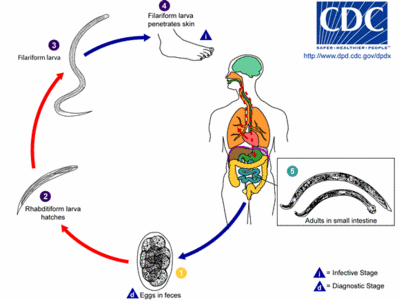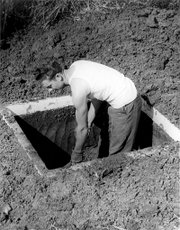In the obscurity of Amoy, South China, a lone Scotsman working with the most humble medical resources uncovered the remarkable mystery of filariasis. He not only enriched the world of medicine with numerous contributions on several tropical diseases, but also initiated a new era of thinking that winged arthropods may be associated with the spread of disease in man. In 1899, his pioneering efforts led to the establishment of a new discipline in medicine and the founding of the London School of Tropical Medicine.
The lone Scotsman was Patrick Manson (1844-1922), who was born in Aberdeenshire, Scotland, the second in a family of 9 children. At the age of 15 years, he was apprenticed to an ironmaster's firm in Aberdeen, but a breakdown in health prevented him from continuing this pursuit. The young Manson therefore turned to medicine at Aberdeen University, and passed his final examinations by the age of 20. By regulation, he had to be 21 years old to obtain his medical degree. Mansor's thesis on the internal carotid artery was his first paper, written while he was a medical officer at the Durham Lunatic Asylum; for this work he was awarded his MD in Aberdeen.
In 1866, Manson traveled to Formosa, as medical officer to the Chinese Imperial Maritime Customs. Thus started a lifelong connection with the tropics and tropical diseases. After 5 years in Formosa, he was transferred to Amoy, China, where he would live for 13 years. Manson was in charge of a hospital for seamen and another missionary hospital. Practicing medicine in these areas was not easy for a Westerner at the time, but the persistent Manson slowly won the trust of the local population. Besides his busy medical practice, which included many surgical operations, Manson devoted his spare time to his passion, research on filaria. Manson's scientific inquiries were aided only by his extraordinary will and curiosity, and his microscope.
Filarial disease, which causes the disfiguring elephantiasis, was highly prevalent in Manson's patient population in Amoy. Surgery was necessary in advanced cases, but the local population initially resisted his efforts. By an unusual twist of fate, Manson was eventually able to convince local residents of the value of surgery. A 19-year-old man who had been weighed down by an enormous elephantoid tumor had become so overcome with grief that he tried on more than one occasion to commit suicide by swallowing arsenic. The dose the man consumed was so high, however, that he became violently ill before the poison could take effect. The man decided that he might as well take his chances with a knife-wielding foreigner and allowed Manson to operate on him. The operation was a success, and it helped establish the community's faith in Manson. During the next few years, a large number of people afflicted with elephantiasis came to Manson for surgery.
Manson worked alone in a far corner of the world, deprived of both intellectual stimulation from peers and a forum for scientific discourse. In 1875, he returned to England to learn what was known about elephantiasis and chyluria. Manson found that there was no school in London that provided any insights to this disease; this void no doubt was responsible for sowing the seed in his mind of the need for a tropical studies center. Frustrated in his search for information on filaria, Manson ended up at the British Museum. Here he came upon Timothy Lewis' account of discovery of a microscopic worm, which Lewis had named Filaria sanguinis hominis, in the urine and blood of patients with chyluria in Calcutta, India.
Based on his assessment of the blood of patients with filariasis, Manson calculated that at times there may be as many as a couple million embryos in a patients circulation. He surmised that not all of these embryos could come to maturity in the same host without killing themselves and their host by overpopulating. He reasoned that another host must be involved in their exit from humans. Manson correctly deduced that this vector was the mosquito and focused on the common brown mosquito of the Culex species.
Manson fed some mosquitoes on the blood of his servant, Huito, who suffered from filariasis. Examining the mosquitoes under his microscope, Manson beheld a remarkable sight:
I shall not easily forget the first mosquito I dissected. I tore off its abdomen and succeeded in expressing the blood the stomach contained. Placing this under the microscope, I was gratified to find that, so far from killing the filaria, the digestive juices of the mosquito seemed to have stimulated it to fresh activity.
Manson also discovered that the filarial embryos (microfilariae) disappeared from the blood of the patients at certain times of the day. He noted that they escaped into the circulation at regular intervals of 24 hours, their discharge commencing soon after sunset and continuing almost until midnight, after which time their numbers gradually decreased. Manson commented, "It is marvelous how Nature has adapted the habits of the filariae to those of the mosquito. The embryos are in the blood just at the time the mosquito selects for feeding."
That the mosquito was the intermediate host of the filarial parasite was a momentous discovery in 1877. These results were published by Manson in the China Customs Medical Report in 1878, and relayed by Spencer Cobbold to the Linnean Society in London. Of his research, the humble Manson wrote to Cobbold, "Men, like myself, in general practice, are but poor and slow investigators, crippled as we are with the necessity of making our daily bread." That the adult filarial worm was lodged in the lymphatics was first discovered by Joseph Bancroft, of Brisbane, Australia, and subsequently by others, including Manson, who found the worm in the scrotum of a patient. Manson correctly surmised that chyluria and elephantiasis were manifestations of lymphatic obstruction by adult filarial worms.
While Manson played a seminal role in elucidating the pathogenesis of filariasis, he was incorrect in his assumption that the mosquito died after ovipositing and liberating the embryos, which he thought infected drinking water. It was the younger Thomas Bancroft who proved in 1899 that filariae that actively developed in the mosquito were transferred to humans by the act of feeding on blood.
By the end of 1883, Manson had traveled to Hong Kong. Here he was the steering force behind the building of the medical school of Hong Kong. In 1889, Manson left China, hoping to retire in Scotland, but his savings proved inadequate. He moved to London and began practice at 21 Queen Anne Street. Manson passed his examination to become a member of the Royal College of Physicians in a year. In 1892, he was appointed physician to the Seamen's Hospital Society and was in charge of the ward at the Albert Dock Hospital.
Manson's famous 1894 mosquito malaria hypothesis would stimulate Ronald Ross into a frenzy of research and steer him in the right direction in elucidating the life cycle of the malarial parasite. In 1897, Manson was appointed medical advisor to the Colonial Office, and a year later he was appointed Lecturer in Tropical Diseases to the Royal Free Hospital for Women. The same year, he published his famous manual on tropical diseases, an authoritative text that appeared in several subsequent editions. Manson's appeals and persistent endeavors culminated in the founding of the first school of tropical medicine in London in 1899.
Manson received many prestigious honors for his outstanding contributions to medicine. These contributions included not only his research on filaria, but also discovery of the lung fluke, a parasitic worm in dogs, as well as excursions into many arenas of medicine, including liver abscess, dermatological conditions such as pemphigus contagiosus and tinea imbricata, ankylostomiasis, kalaazar, trypanosomiasis, schistosomiasis, typhoid, diphtheria, smallpox vaccination, leprosy, plague, dengue, beriberi, and spree. Manson compressed biopsies of leprous material to rid them of blood and pricked the center to release a droplet of fluid, which he then smeared and examined under a microscope to demonstrate the lepra bacilli.
Manson was a lifelong sufferer from gout and eventually died on April 9, 1922. Not only was he instrumental in making several original discoveries in parasitology and helminthology, but he also lent his relentless support and encouragement to peers in the field, such as Ronald Ross. Indeed, Sir Patrick Manson has been rightfully accorded the honor as the Father of Tropical Medicine.
Accepted for publication June 30, 2000.
From the Division of Pathology, Hospital for Sick Children, Toronto, Ontario, Canada.
The author acknowledges that the general biographical overview presented does not necessarily include all of the accomplishments or achievements associated with the person discussed. Dr Jay welcomes comments from readers concerning the "A Portrait in History" section. Reprints not available from the author.
Copyright College of American Pathologists Nov 2000
Provided by ProQuest Information and Learning Company. All rights Reserved




